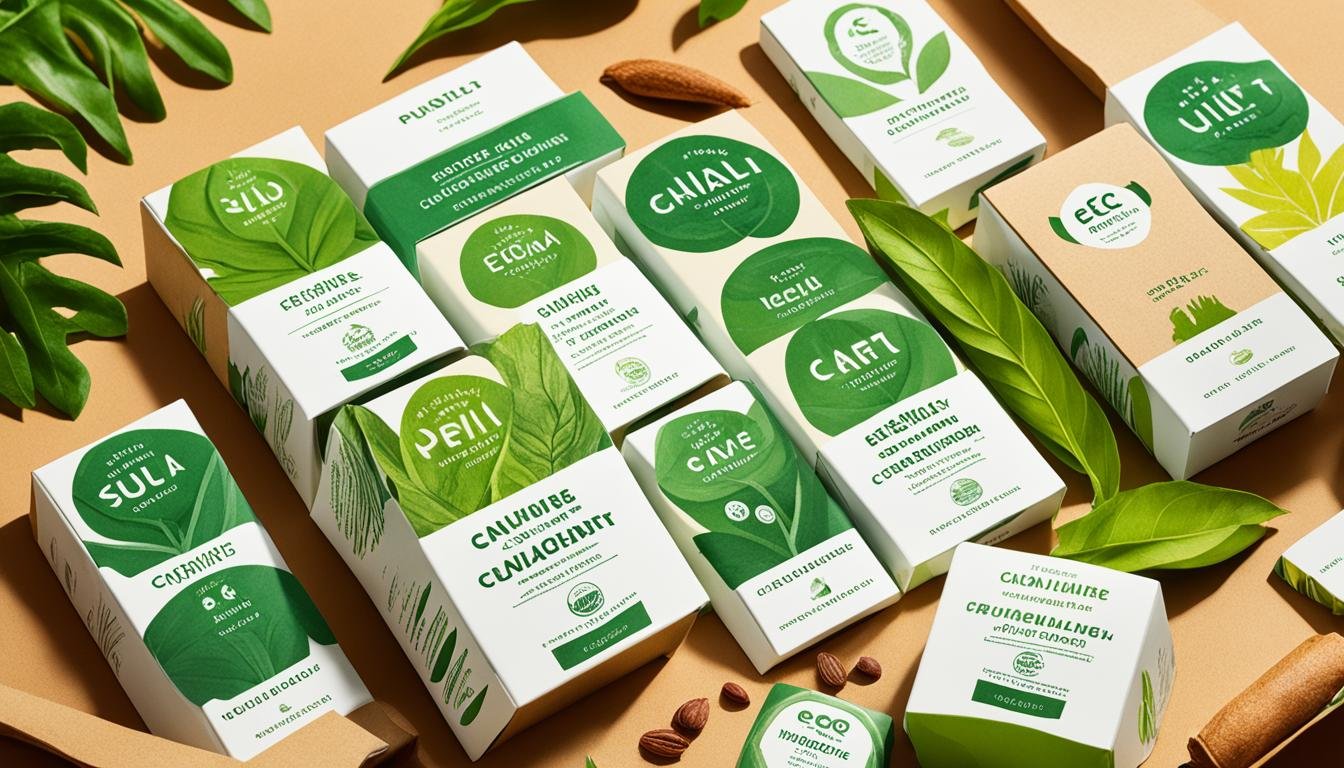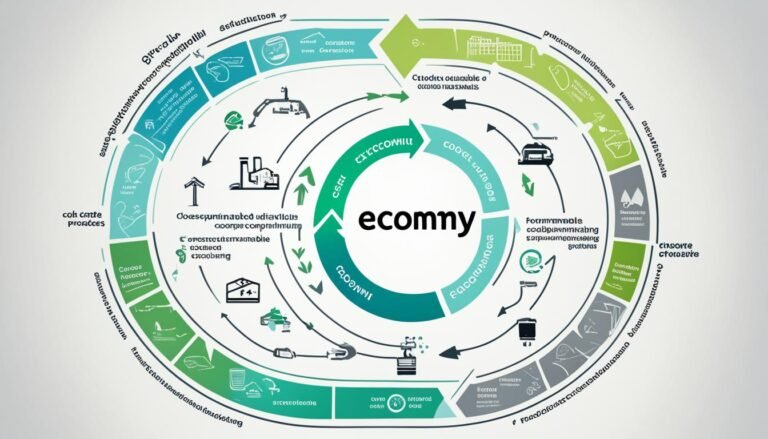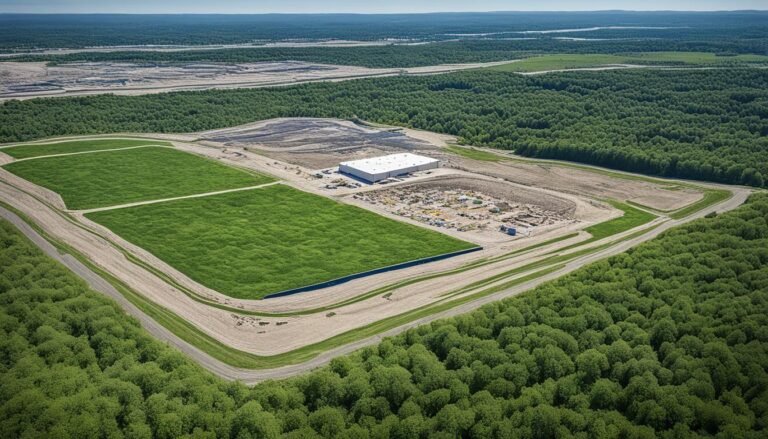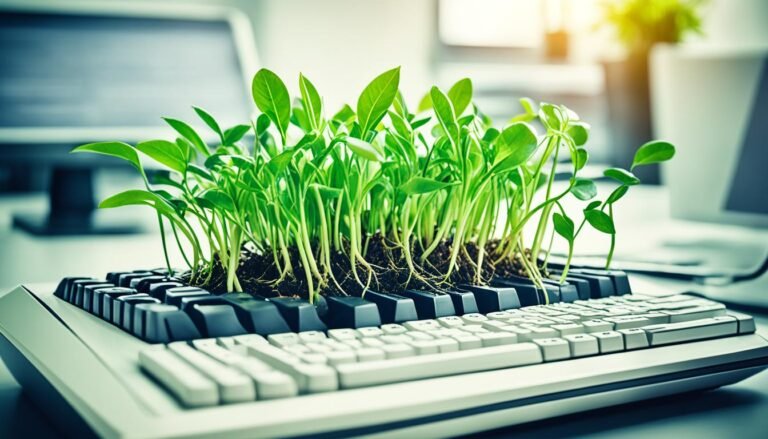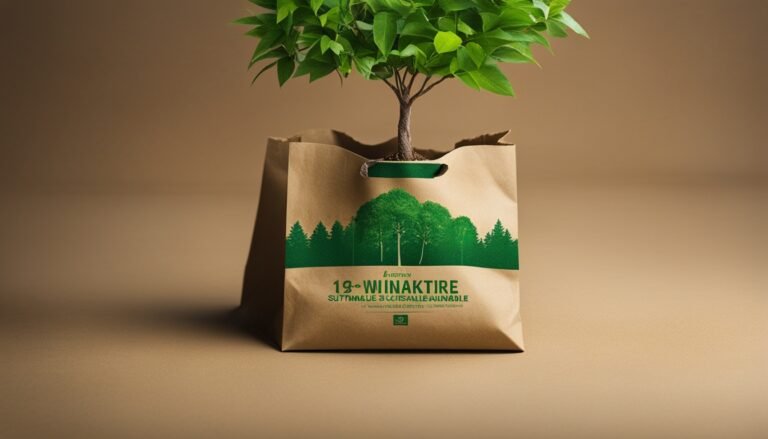Beyond the Label: Choosing Sustainable Food and Beverages
In today’s world, we’re more aware of our impact on the environment. Our food and drink choices matter. It’s not just about taste and health. We look at where our food comes from and how it’s packaged. For people who care about the planet, knowing about food packaging is key.
Sustainable food is about more than just being organic. Most organic eggs come from factory farms. And half of the organic feed in the US comes through Istanbul, bringing fraud problems. To really be sustainable, we need to look beyond the labels.
Friend of Glass is leading a movement to check food packaging. Glass is natural and can be recycled over and over. It keeps food safe without adding any bad chemicals. Top experts say glass is safe, making it a great choice for our planet and our health.
Key Takeaways
- 95% of organic eggs are factory-farmed despite the organic label.
- 50% of organic feedstuffs into the US involve constant fraud through Istanbul.
- Fresh chicken can be stored for a year at 26°F and still be labeled “fresh.”
- Glass packaging is infinitely recyclable and safer for long-term food storage.
- Consumers are increasingly concerned about the environmental impact of their purchases.
Understanding Sustainable Food Choices
Today, choosing the right foods is key in our green world. Many are working to eat in a way that’s good for the planet and themselves. To get this right, we need to know what makes food choices sustainable.
What Defines Sustainable Food and Beverages?
Sustainable foods help the planet and bring good to our society and economy. They don’t use too many resources or harm the earth much.
- Eating more plants and insects is good.
- Eating less meat helps.
- Choose foods that are in season.
- Look for local or organic foods, too.
Knowing this helps us pick food that’s eco-friendly. It’s about making choices that support our planet and communities.
The Importance of Sustainable Eating
Eating sustainably is vital for our Earth’s future. Household food choices play a big role in pollution and using up earth’s resources. Changing how we eat matters, especially in wealthier places.
Sustainable eating can make a big difference. In Australia, switching from some meats to others for a week cut one family’s emissions by 30%. These changes help the planet and our health.
Common Misconceptions About Sustainability in Food
Some people think eating sustainably is hard or expensive. But, with a bit of planning, it can be easy and not break the bank. Being open to new food habits is the first step.
Many don’t realize the true cost of certain foods on the Earth. For example, they underestimate how much harm red meat does. Correcting these wrong ideas is key to smart, sustainable eating.
The Impact of Packaging on Sustainability
The way food is packaged affects our planet. Both making and throwing away packaging can harm the environment. It’s important to look at how packaging choices relate to being sustainable. This includes the benefits of picking eco-friendly options.
Why Packaging Matters
Food packages do more than just hold what’s inside. They are key in how goods are used and then discarded. Choosing packages made from recycled materials is a big step. It helps lower the amount of harm done by packaging, something more and more people care about.
To really make a difference, everyone involved in making and selling food needs to work together. This includes the people who supply the materials, those who make the packaging, and those who deliver the products. Working as a team means better results for the environment. And it’s good for business too.
The Advantages of Glass Packaging
Glass stands out as a top choice for the environment. It can be recycled again and again without losing quality. This makes it better than plastic in many ways.
Glass also keeps food safe from harmful chemicals. It’s good for the planet and for people who want quality and eco-friendly stuff. Its benefits make it a clear favorite for many.
Big companies like Coca-Cola and Unilever are moving towards glass for a better future. Glass needs less energy to make and makes the air cleaner. This helps the planet and supports the growth of sustainable packaging.
Eco-Friendly Products You Should Know About
More people are choosing eco-friendly options today. This includes eating plant-based, using products made with care, and reducing waste. These changes help our planet a lot.
Benefits of Plant-Based Diets
Plant-based diets are great for the environment. They reduce the gases that cause climate change. They also save water and land. Many younger people and even older generations are interested in these benefits.
Sourcing Ethical Ingredients
Using ethical ingredients helps animals and workers. For example, FSC-certified paper comes from forests managed in a good way. More people, from younger to older ones, want these kinds of products.
Reducing Your Carbon Footprint
Everyone can cut down on their carbon footprint. This is through better packaging and what we buy. Companies like Pela Case and Oakywood make things in eco-friendlier ways. They show others how to consume smarter too.
The demand for eco products is growing fast. It proves we’re all working together to keep the earth safe.
Regenerative Agriculture: The Future of Farming
As more people see the need for sustainable farming, regenerative agriculture is gaining attention. It’s a way forward that makes our farms better for the planet.
What is Regenerative Agriculture?
It’s a method that looks at farming as a whole. It wants to make soil healthier, increase the number of plants and animals, and make ecosystems thrive. This is different from the usual farming that can harm the soil and relies on chemicals.
Regenerative farming aims to create systems that are healthy on their own. It does this by keeping the soil covered, not disturbing the soil too much, and planting a mix of things. It also includes letting animals graze on the land.
Benefits of Regenerative Practices
Choosing regenerative farming brings many good outcomes. Healthy soil can store a lot of carbon, which is great for the climate. These methods make soil hold more water, needing less human effort to grow food. They also make farms more diverse and resilient.
By using regenerative ways, farmers use fewer machines and chemicals. This means they are kinder to the planet.
How to Support Regenerative Farmers
Helping these forward-thinking farmers is key to making better farming common. Here’s how you can help:
- Purchase Products from Regenerative Farmers: Buying food from farms that farm in regenerative ways shows you support healthy farming.
- Advocate for Policy Changes: Ask your leaders to back policies that encourage regenerative farming. Things like funding for farmers to use better farming methods.
- Raise Awareness: Tell others why healthy soil and balanced ecosystems matter. This can make more people choose food grown in a way that’s good for the planet.
Backing regenerative agriculture is a real step we can all take. It’s a move towards farming that’s not just good for nature but better for everyone in the long run.
Preventing Food Waste at Home
Preventing food waste is key to a green house. Good meal planning, storing food well, and using leftovers smartly help a lot.
Planning meals in advance cuts down on waste. It means you buy just what you need. This helps lessen the 38% of food that’s wasted in the U.S., equal to 145 billion meals yearly.
Freezing food lowers waste, too. Their’s 47% less thrown-out food in homes that freeze meals. It allows us to save items like fruits, veggies, or bread for months. Mark leftovers with the date to eat them by, and they stay good for 3-4 days longer.
Don’t forget about using up leftovers and scraps. Turn veggie scraps into stock to cut waste and use your products fully. If veggies go limp, add water to perk them up, instead of tossing them.
Composting is a great way to drop waste and better the soil. Food waste leads to 1/3 of our greenhouse gas effect. Tesla has a project that saved 50 million fruits and veggies from being thrown away in 2021. It shows how we all can help.
By following these tips, homes can greatly reduce trash. These easy steps are a big win for our planet. They lead us to a greener future for all.
Choosing Local and Seasonal Ingredients
Choosing local and seasonal foods is more than a fad. It’s a way to help the earth and our bodies. We get to eat fresher, healthier food. Plus, we lower our impact on the planet.
Understanding Seasonal Produce
Seasonal produce is at its best when harvested. Eating fruits and veggies in season means they’re tastier and full of nutrients. They get the chance to fully develop their flavor and goodness.
Every season brings a new set of items. Spring gives us asparagus and rhubarb, while summer delights us with blueberries and tomatoes. Fall brings apples and pumpkins. Then, winter shines with Brussels sprouts and citrus fruits. This cycle keeps our menus exciting and our diets balanced.
Why Local Ingredients Are Better
Local foods are usually fresher because they come from nearby. This shortens the time from farm to table. It keeps the food’s nutrients intact. Also, it cuts down on the pollution from long journeys.
Buying local supports the local economy and reduces farmland loss. It also leads to joining CSA programs. These let you get fresh food deliveries from farms. This way, you connect directly with the people growing your food. It builds a strong community and supports the idea of sustainable living.
How to Find Local Producers
There are easy ways to find local growers. Visit farmers’ markets. Supermarkets are also stocking more local vegetables, making it easier to shop local. Look for those options when you go grocery shopping.
Joining a CSA program is another good step. It connects you with fresh, seasonal produce from local farms. You also can look for special labels on product packaging. These show that the item was sustainably produced.
By picking local and seasonal foods, we help our planet and ourselves. It’s our active choice for a sustainable future. These steps are powerful in making a big difference for our environment and health.
Fair Trade Practices and Their Importance
Fair trade practices are key in making sure farmers and workers are treated well and paid fairly. They work under ethical conditions. This helps not just the workers but also builds a better community. The use of fair trade certification is common in products like cocoa, fruit, sugar, and more. This shows how it makes a difference in the world. Let’s see how both the makers and the buyers benefit from it.
Fair Trade Certification
Fair trade certification promises that products follow high ethical standards. Fairtrade International is an example. It helps almost two million farmers and workers in nearly 80 countries. They get a Minimum Price and a Premium payment. These are to lessen poverty among food producers. The criteria they have ensure the products meet certain social and environmental goals.
“Sales of fair trade products increased by almost 14% between 2019 and 2020. It shows more people want goods that are produced ethically.”
The World Fair Trade Organization also checks on brands that say they are fair trade. They do this through reviews and checks. This helps people trust that the products they buy do support fair trade.
The Benefits to Farmers and Workers
One big benefit of fair trade is the direct support for farmers and workers. Companies that follow these standards help their workers do better. They get a stable income and work in good conditions.
- Fairtrade International makes sure farmers get a fair price, even if market prices fall.
- A bonus payment helps communities grow and improve.
- With Fair for Life certification, producers usually get a 10% extra beyond the market price.
This push for fairer trade doesn’t just help farmers. It starts a chain reaction. This leads to better community development and helps fight global poverty. More and more people are demanding fair trade products. This shows companies it’s important to support fair trade.
Overall, fair trade makes a big impact on how we buy and sell things. People choosing fair trade products are making the world better. The growing interest in fair trade shows we care about how products are made. It’s a step towards a kinder, more equal world economy.
Compostable Packaging and Its Benefits
Compostable packaging is getting popular as a green choice over regular plastic. It’s made from plant stuff, so it breaks down in the soil. This way, it’s good for the environment, cutting down on waste and helping the earth.
What is Compostable Packaging?
Compostable packaging turns into safe parts like water and carbon dioxide in about three to six months. This is way faster than old plastics that stick around for hundreds of years. Big names like San Francisco Bay Coffee and Oakland Coffee Works are leading the way, using it for their products.
The Environmental Impact of Composting
Around the world, most plastic is used for food wrappers, creating tons of waste. In the UK, too much plastic isn’t even recycled. But, using compostable packaging reduces this mess, cutting down on harmful gases like methane.
Also, a huge amount of food is thrown away in the EU every year. Composting and using green products can help a lot. They make our world cleaner and healthier.
Practical Tips for Using Compostable Products
- Know Your Labels: Look for certifications and labels showing it’s compostable.
- Community Composting: If you can’t compost at home, check out community composting.
- Reuse Where Possible: Some compostable things can be used again before you throw them out.
People want more eco-friendly options, and they’re getting them. Businesses are making compostable stuff to cut back on trash. By using and composting these items, we all make the planet healthier.
Compostable packaging is an important step towards making less waste. More people and brands are choosing the green way. As the idea spreads, it helps move us towards a better future.
Beyond the Label: Choosing Sustainable Food and Beverages
Living sustainably is more than checking product labels. It means knowing how our choices affect the world. By learning, we can pick eco-friendly options and help the planet and people.
“55% of consumers are more likely to purchase a packaged food item with a sustainability claim.”
When thinking about food and drink choices, many aspects come into play. Going green can help companies by improving their money and reducing their waste. Still, not many are hitting their eco-goals. This shows we must keep pushing for greener options and make sure traders and shoppers are in the know.
Recognizing reliable labels, like USDA Certified Organic and Fair Trade, is key. These logos show that our food picks are not just passing fads. They show a deep, real commitment to being green.
Plus, soon, more products will spell out their green efforts on their packaging. This is because brands and sellers are working hard to earn your trust in the earth-friendly and social area. Even simple changes, like eating more plant meals, can cut your personal environmental impact a lot.
To wrap things up, making wise food and drink choices is crucial for a green life. Understanding the whole process from start to finish is vital. This way, our everyday actions can really help push for a healthier planet.
Conclusion
Choosing sustainable food and drinks is now a key movement. It aims to reduce our impact on the environment. By following sustainable practices, we can greatly lessen the use of our natural resources.
This movement also helps in tackling global environmental issues. People are starting to see the value in paying more for goods with sustainability labels. This shows their growing concern for the planet.
The EU Organic Farming label is a popular choice among European consumers. They prefer it over private labels. But, there is still confusion around what these labels truly stand for.
Bringing clarity to these labels can sway consumer choices and their willingness to pay more. Often, food labels are crucial in helping people make decisions that reflect their values.
It’s not just about the label, though. Choosing products with these labels can support regenerative farming and fair trade. These actions can combat the negative effects of food production.
Organic farms, for example, use less energy and produce fewer carbon emissions. Also, buying local food helps cut down on the pollution caused by transporting goods. Each sustainable choice we make helps build a better future for our planet.
Source Links
- Beyond Labels
- What’s a Sustainable Label? | Ultimate Guide on Sustainable Labels
- Whetting Consumers’ Appetite for Sustainable Foods
- Environmentally Sustainable Food Consumption: A Review and Research Agenda From a Goal-Directed Perspective
- Study confirms carbon label efficacy: ‘They had the predicted effect… lower-emission food choices’
- Exploring Sustainable Food Choices Factors and Purchasing Behavior in the Sustainable Development Goals Era in Spain
- Council Post: Embracing Sustainability: The Rise Of Eco-Friendly Packaging Solutions
- Why food and beverage buyers are choosing sustainable secondary packaging
- Exploring the Science of Sustainable Food Packaging and Its Impact on Climate Change – Food Industry Executive
- Eco-Friendly Labels for Environmentally-Conscious Brands
- 34 Eco-Friendly Products To Sell in 2024 – Shopify
- Onya
- Regenerative Agriculture: The Next Frontier in Sustainable Food Production – KnowHow
- Regenerative Agriculture: Sustainability in Farming
- Can regenerative farming save our food and future?
- Tackling Food Waste at Home
- Food Waste Solutions – Reduce Food Waste, Food Recycling & Recovery
- 11 Effective Solutions for Food Waste | Earth.Org
- Eating seasonally and locally has many benefits. Is fighting the climate crisis one of them? | CNN
- The Role of Local Seasonal Foods in Enhancing Sustainable Food Consumption: A Systematic Literature Review
- The Importance of Sourcing Local, Seasonal and Sustainable Produce
- A quick guide to fair trade and food | Ethical Consumer
- Fairtrade forecasts transparency, regenerative programs and private label opportunities in 2024
- Consumer Interaction with Sustainability Labelling on Food Products: A Narrative Literature Review
- Sustainable Food Packaging
- 4 Reasons Why Consumers Want Compostable Packaging – SheetLabels.com
- What is Compostable Packaging? Exploring Sustainable Solutions
- Choosing the Best Sustainability Label for your Brand – HowGood
- Plant-based eating for a more sustainable future
- How environmental sustainability labels affect food choices: Assessing consumer preferences in southern Italy
- So, Is Organic Food Actually More Sustainable?
- What Is Sustainable Food, and How It Can Help Combat Climate Change

